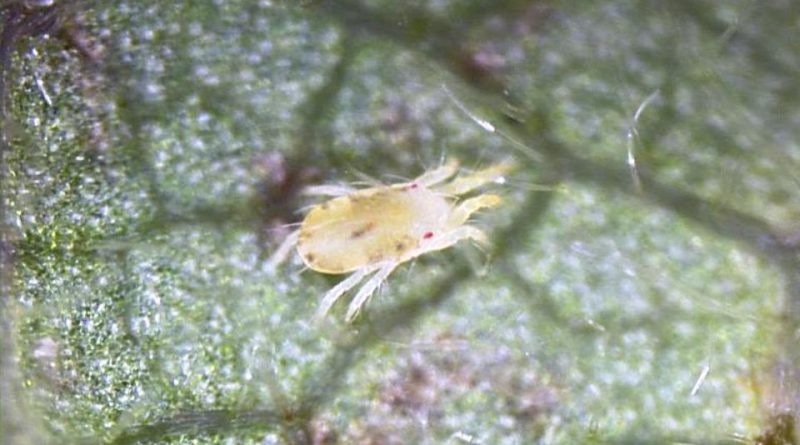Eotetranychus carpini
Eotetranychus carpini
The yellow spider mite (Eotetranychus carpini Oudemans) is a mite belonging to the Tetranychidae family.
Systematics –
From a systematic point of view it belongs to:
Eukaryota domain,
Kingdom Animalia,
Subkingdom Eumetazoa,
Bilateria branch,
Superphylum Protostomia Ecdysozoa,
Phylum Arthropoda,
Subphylum Chelicerata,
Class Arachnida,
Subclass Acari,
Prostigmata Order,
Family Tetranychidae,
Subfamily Tetranychinae,
Eurytetranychini tribe,
Genus Eotetranychus,
E. carpini species.
The term is basionym:
– Tetranychus carpini Oudemans, 1905.
The terms are synonyms:
– Eotetranychus carpini subsp. borealis (Ewing, 1913);
– Schizotetranychus (Eotetranychus) carpini (Oudemans, 1905);
– Schizotetranychus carpinula Reck, 1950;
– Schizotetranychus carpinula Reck, 1950;
– Schizotetranychus pterocaryae Reck, 1950;
– Schizotetranychus pterocaryae Reck, 1950;
– Tetranychus borealis Ewing, 1913;
– Tetranychus carpini Oudemans, 1905;
– Tetranychus flavus Ewing, 1913;
– Tetranychus monticolus McGregor, 1917;
– Tetranychus oregonensis McGregor, 1917.
Geographic Distribution and Habitat –
The Eotetranychus carpini is a polyphagous mite but which creates particular problems as a parasite of the vine and some broad-leaved trees, especially the hornbeam.
It is mainly present in Europe and Asia. Its natural habitat is associated with deciduous trees belonging to the Carpinus genus. This mite feeds on the sap of the leaves and can cause significant damage to trees if their population increases unchecked.
As for the specific habitat, the E. hornbeam is mainly found in forests and wooded areas where Carpinus trees grow. They prefer areas with temperate and humid climates, as these conditions are favorable for their reproduction and survival.
Morphology –
The wintering females of Eotetranychus carpini are variable in color from golden yellow to yellow-orange while the spring-summer females have a yellow-green color with darker spots on the sides of the body and with clearly visible red eyes. Females measure less than 0.4 mm while males are smaller and thinner.
The colonies are found on the underside of the leaf near the veins, often covered by silky threads.
Attitude and biological cycle –
The Eotetranychus carpini is a spider mite that winters under the rind as a fecundated female. In spring the activity on the young shoots resumes. From these, 7-8 spring generations are formed.
Annually it completes from 6 to 8 generations depending on the temperatures, however most are concentrated in the period of late spring and summer.
This little mite bites the leaves to feed on their sap; the evident signs are the result of these punctures, small yellow-orange spots which initially localized in the case of serious infestations merge into large spots which lead to the desiccation of the leaf and its fall (phylloptosis). The attack is localized on the lower page of the leaves but the signs are clearly visible on the upper pages.
Ecological role –
In the containment against the infestations of Eotetranychus carpini it must be taken into account that there are numerous natural predators; the most important are the Phytoseiid mites (Typhlodromus spp, Amblyseius andersoni, Kampimodromus aberrans); other natural predators of the harmful mites are insects such as the ladybird Stethorus punctillus, the crisopes, the anthocorids, the myrids. It is seldom necessary to resort to chemical defense; in this case, very effective selective acaricide products are commercially available.
In case of a consistent attack, the damage is caused by the stings. The young shoots have an irregular and stunted development. Young leaves show necrotic pitting, with subsequent deformation. Late attacks cause chromatic alterations to the already formed leaves with subsequent reddening and yellowing. Finally there is a necrosis of these areas and this causes a poor accumulation of sugars in the grapes.
The fight is mainly carried out with preventive practices: carry out the correct cultural practices; do not exceed with nitrogenous fertilizations, check vigor.
The intervention must be preceded by an accurate sampling both in the budding phase of the plant and in the middle of summer. The intervention threshold is equal to 60-70% of leaves where the mobile form of the spider is present.
Guido Bissanti
Sources
– Wikipedia, the free encyclopedia.
– GBIF, the Global Biodiversity Information Facility.
– Laffi f., 1983. Mites of agricultural interest. University Library Publishing Cooperative. Bologna.

